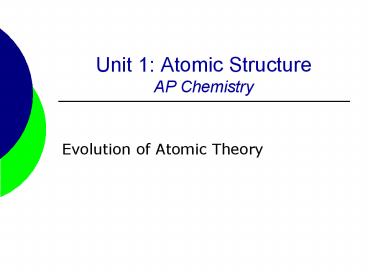Unit 1: Atomic Structure AP Chemistry - PowerPoint PPT Presentation
1 / 39
Title:
Unit 1: Atomic Structure AP Chemistry
Description:
Alchemists attempted to turn metals into gold and developing the elixir of life ... theory No experimental evidence Supported by Sir Isaac Newton Robert ... – PowerPoint PPT presentation
Number of Views:317
Avg rating:3.0/5.0
Title: Unit 1: Atomic Structure AP Chemistry
1
Unit 1 Atomic StructureAP Chemistry
- Evolution of Atomic Theory
2
Democritus 400 B.C.
- Greek Philosopher
- Imagined particles that were indivisible
- Constituents of matter
- Atom comes from atomos
- Opposed Aristotle
3
Aristotle 350 B.C.
- Widely accepted theory that all matter can be
continually divided. - Set science back for thousands of years.
4
Alchemy
- A pseudoscience that superceded scientific
discoveries. - Alchemists attempted to turn metals into gold and
developing the elixir of life (able to cause
immortality and create life).
5
Pierre Gassendi - 1650
- Reintroduced Particulate theory
- No experimental evidence
- Supported by Sir Isaac Newton
6
Robert Boyle - 1661
- Studied Gases
- 1st to use the term element in its current
context in his book The Skeptical Chemist
7
George Stahl - 1717
- Suggested phlogiston flowed from burning
material - A necessary ingredient of combustible material
8
Joseph Priestly - 1774
- discovered oxygen supports combustion
9
Antoine Lavoisier - 1778
- Developed Law of Conservation of Mass
- Explained combustion
10
Joseph Proust - 1799
- Developed Prousts Law using copper oxide
- Later renamed, the Law of Definite Proportions
- Nearly discovered the Law of multiple
proportions, but his data used percentages
instead of weights.
11
John Dalton - 1802
- First to develop an atomic theory. It has 4
postulates. - Each element is made up of atoms
- Atoms of the same element are identical in mass
and properties. Atoms of different elements
differ in some way.
12
John Dalton - 1802
- Compounds are made when atoms combine. If
elements combine in more than one whole number
ratio, the resulting compound has different
properties - Chemical reactions involve the reorganization of
atoms.
13
Amedeo Avogadro - 1811
- Developed Avogadros Law. Equal volumes of gases
have equal number of molecules at constant
temperature and pressure. - Expanded Daltons concept of atomic masses
14
J.J. Berzelius - 1813
- Established the 1st system of using letters to
represent elements.
15
William Prout - 1815
- Proposed that Hydrogen was the fundamental
material that all other elements were made from.
All atomic masses were multiples of the mass of
hydrogen.
16
Michael Faraday - 1833
- Found Faradays Constant. 1 mole of e- 96500
coulombs.
17
Alexandre Béguyer de Chancourtois - 1862
- 1st periodic arrangement of elements.
- Divided surface of a cylindrical base into 16
segments because oxygen has a mass of 16.
18
John Newland - 1863
- Developed the law of octaves
- Properties of elements repeat every eighth
element.
19
Dimitri Mendeleev - 1869
- Classification based on chemical properties.
- Considered the first periodic table.
- Left gaps for missing elements and predicted
their properties
20
William Crookes - 1879
- Showed that cathode rays stream from the negative
pole
21
Eugene Goldstein - 1886
- Discovered the proton using a cathode ray tube.
22
William Roentgen - 1895
- Discovered x-rays.
- Rays were penetrating and of short wavelength
23
Henri Becquerel - 1896
- Discovered radioactivity.
- Used uranium salts
24
Marie Curie - 1897
- Student of Becquerel
- Showed that radioactivity is atomic property
- Isolated radium and polonium
25
J.J. Thomson - 1897
- Determined the mass/charge ratio of the electron.
- 5.69 x 10-9
- Used the cathode ray tube
- Proposed a model of the atom that was mockingly
called the plum pudding model
26
Robert Millikan - 1909
- Determined the charge of the electron using the
famous oil-drop experiment - 1.60 x 10-19
- From this and Thomsons value, the mass was
calculated to be 9.11 x 10-28g
27
Ernest Rutherford - 1911
- Performed the famous gold foil experiment
- Determined 3 things
- The atom is mostly empty space
- The nucleus is positively charged
- The nucleus is a small dense part of the atom
28
Gold Foil Experiment
29
Gold Foil Experiment
30
Henry Moseley - 1913
- Calculated atomic number by determining the
nuclear charge of an atom.
31
Niels Bohr - 1913
- Observed spectral lines for hydrogen
- Proposed an orbit theory of the electron around
the atom.
32
Bohr Model
33
Hydrogen Spectrum
34
Gilbert Lewis - 1916
- Suggested that noble gases have 8 valence
electrons - Atoms will gain or lose electrons to achieve 8
outer electrons.
35
Louis De broglie - 1924
- Suggested that matter could exhibit wave
properties - Observed diffraction patterns in electrons
36
Wolfgang Pauli - 1924
- Pauli Exclusion Principle 2 electrons cannot
have the same 4 quantum numbers
37
Erwin Schrödinger - 1926
- Developed a wave equation.
- Mathematical function that described the nature
of the electron
38
James Chadwick - 1932
- Discovered the neutron
39
Other Contributions
- C.D. Anderson 1932
- Discovered the positron
- Enrico Fermi 1940
- Prepared more than 40 radioactive elements

